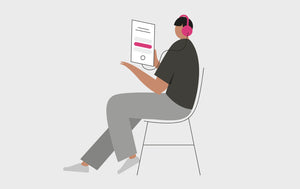Natural Remedies and Scientific Methods: What Dissolves Ear Wax?
Everyone has ear wax. It’s produced by your body to protect and moisturise the skin of the ear canal to prevent getting dry, itchy ears. It also contains chemicals to fight off infections and acts as a shield from external factors like dust and dirt.
Sometimes an excessive amount of ear wax can build up, leading to itchiness, pain and even mild hearing loss. If you are suffering from any irritation or itchy skin, be sure to check out our Eargene Skin Relief to ease any discomfort.
Understanding ear wax
Ear wax is made up of substances called cerumen and sebum, an oily substance. Both are made by glands in the outer ear canal. It also contains dead skin cells and hair.
Most of the time ear wax removes itself by moving towards the outer opening of the ear and falls out or is washed away during normal cleaning routines. Sometimes though, too much ear wax can build-up and it becomes harder to get rid of.
An excess of ear wax can occur for a number of reasons – for example, if you have narrow or damaged ear canals or lots of hair in them, if you have a skin condition affecting your scalp or around your ear, or if you have any inflammation of your ear canal.
If you wear hearing aids, this can also contribute to a build-up of wax in your ears.
Common symptoms of wax impaction
There are many symptoms of having excessive ear wax or wax impaction. You might experience earache, itchiness, dizziness or even tinnitus and mild hearing loss. These can all feel irritable but there are several ways you can resolve the problem.
Natural Remedies to Dissolve Ear Wax
Can you remove earwax at home? Well, before you go to the doctors, there are some natural ways and products to try and alleviate excess or compacted ear wax which you can undertake at home.
- Olive oil
Warm (body temperature) olive oil can help to soften any hard wax in your ear. To do this, use an eyedropper to apply a few drops of oil into your ear, three to four times a day. This will help to soften the wax and it should make its way out of your ear naturally. Or, check out our Earol Olive Oil Spray to make the process even easier.
- Hydrogen peroxide
You can use small, diluted amounts of hydrogen peroxide to break up ear wax, but be careful – if you use the wrong concentration it can cause inflammation and earaches. You also need to be careful using it around the skin of your ears as this can also cause irritation.
You might prefer to use over-the-counter, hydrogen peroxide ear drops as this will be measured out accurately (see next section below).
- Warm water
Warm water and salt water can also be used to help soften wax in the ear canal. You can buy rubber-bulb syringes to gently squirt warm water into the ear canal. Once done, tilt your head to the side to allow the water to drain out. Afterwards, gently dry your ear with a towel. If you’re using salt water, a ratio of half a teaspoon of salt to half a cup of water is recommended. Again, use warm water which is about body temperature, so you don’t shock your body or cause damage.
Remember, never attempt to dig out excessive or hardened ear wax with items such as cotton buds, hair grips or paper clips. And don’t put any liquids into your ear canal if you have a perforated eardrum. If using a bulb syringe, make sure to fully read the instructions to keep your ear canal safe from damage.
The Mayo Clinic offers some advice on self-care measures that can help to remove excess ear wax.
-
Over-the-counter Solutions and their efficacy
There are plenty of over-the-counter solutions to help soften and get rid of ear wax. Ear drops are a popular and cost-effective way of softening stubborn ear wax.
You can buy water-based ear drops and sprays which contain sodium bicarbonate or hydrogen peroxide, or oil-based ones which contain olive oil or almond oil (be careful to read ingredients if you have allergies). These are easily available to buy at your local chemist or online for around £5.
As mentioned with the home remedies, oils will help to soften stubborn ear wax and drops which contain hydrogen peroxide or other kinds of peroxide help to break up ear wax.
Currently there isn’t any evidence to one of these remedies being superior to the other. They’re all designed to be absorbed by the ear wax to soften it and to lubricate the layer of skin lining the ear canal to help move it out of the ear, and they’re all a similar price to buy.
Don’t use drops if you have a perforated eardrum and as with home remedies don’t stick items in your ear to try and dig wax out as you can cause a perforated eardrum.
- Ear irrigation kits
You can buy ear irrigation kits for home use but they are expensive, and as this article from Which? states, they can be ineffective and risky.
You may have heard doctors and health professionals say, “never put anything in your ear smaller than your finger” and it’s for good reason. The eardrum is very sensitive and can be easily torn.
Many of these kits come with a tool to be able to scoop wax out manually – if you’re doing it to yourself, you won’t be able to see down your own ear canal, and if someone inexperienced is helping you, they could easily and inadvertently push the tool too far down or make wax worse by pushing it further in.
Ear canals are not straight tubes, and you could easily poke in the wrong place if you don't know what you're doing.
When should you consult a medical professional?
Current NHS guidelines on when you should get medical intervention for excessive ear wax are if:
- Your symptoms have not cleared after 5 days
- Your ear is badly blocked and you can’t hear anything (you can get an infection if it has not cleared)
Your GP practice will most likely arrange an appointment with a nurse, who will take a good look down your ear canal to see if they can see any build-up of wax.
Not all GP practices will remove earwax and you may have to pay to have it done privately. Many high street audiologists provide this service for around £50 and upwards.
If you do decide to undergo professional ear wax removal, it’s usually done by ear irrigation or microsuction.
Ear Irrigation
With water irrigation, body temperature water is used to flush wax and out of the ear canal at a low pressure. The aim is to pump water in behind the ear wax to flush it out of the ear. There are limitations on who it can be performed on though (e.g. you can’t have it done if you’ve had a perforated eardrum or had a middle-ear infection in the previous six weeks), so check with the medical professional to see if you’re a suitable candidate.
Ear irrigation is usually performed by NHS GPs and nurses or private audiologists and typically takes between 15-30 minutes.
As the patient, you’ll be sat with your head slightly tilted so the affected ear is facing upwards. This is to help water travel down the ear canal as it is being squirted. As the water runs back out, a metal cup-shaped basin is placed beneath the ear to collect it and any ear wax it has flushed out.
Microsuction
Microsuction uses a gentle suction device to remove any ear wax blockages.
This suction device acts like a vacuum cleaner, helping to loosen and remove any impacted earwax.
The wax in your ears needs to be soft for this procedure, so you’ll probably need to use a course of ear drops first.
Once the wax is soft, the suction tube and probe will be placed into your ear to remove the wax. It’s usually a painless procedure but can be a little uncomfortable for some people. However, when performed by a trained professional it’s one of the safest ways to remove wax from your ears.
Preventative measures and good practices
As a rule, ears are generally self-cleaning, and earwax is there to remove dirt and debris out of your ear canal.
To keep your ears clean from the outside you can use a warm flannel or cotton wool soaked in warm water to wipe around the outer entrance to the ear canal.
Hearing aids have been known to increase earwax production, so make sure if you’re a user of them to clean them regularly – the same goes if you’re a regular user of earbud speakers. Have a look at our PureClean Cleaning Spray, which is just the tool you need to help you get squeaky clean hearing aids.
As mentioned earlier, never attempt to put anything down your ear canal smaller than your finger – this includes cotton buds, hair grips or paper clips. And don’t put any liquids into your ear canal if you have a perforated eardrum.
Dietary considerations for ear health
Eating a good diet has knock on effects for all aspects of health – and that includes your ears too.
By eating the colours of the rainbow, you can get in all the nutrients you need to keep your ears functioning well. So, what foods can help with this?
Foods to assist your ears and hearing health
Zinc helps to boost the body’s immune system and is also responsible for cell growth and healing, so it’s potentially helpful in warding off ear infections. Zinc can be found in protein-rich foods like beef, pumpkin seeds, tahini and nuts like cashews and almonds. It’s also found in dark chocolate so you can satisfy any sweet cravings you may have at the same time.
Potassium is responsible for regulating the amount of fluid in your blood and body tissue and is important for ear health as fluid in the inner ear needs a rich supply of potassium. Bananas are a rich source of potassium, as are other fruits such as apricots and oranges.
The golden rules for healthy ears
Remember, having ear wax is a normal bodily function. You can keep your ear canals healthy from the inside out by eating a good diet rich in vitamins and minerals. Keeping the outside of your ears clean will help to remove wax that’s made its own way out and any shed skin cells.
If you do get build-up of wax, or are experiencing symptoms that might make you think you have compacted wax in your ears, start at home with over-the-counter remedies to see if they work, such as ear drops made with oil or hydrogen peroxide ear drops. This can take a few weeks to improve or resolve so remember to stay patient.
If you don’t see any improvement, it’s vital you make an appointment to see a medical professional who can advise you on next steps to perhaps get the debris removed professionally.
Be sure to read some of our other articles, ranging from topics such as mild hearing loss, to assistance in buying hearing aids online, and the types of hearing aids we offer to get the best for your hearing health.


